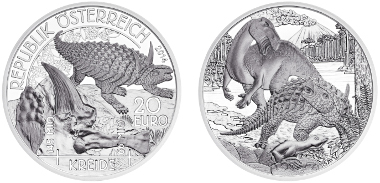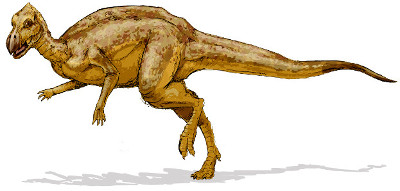March 27, 2014 – On March 19th, the Austrian Mint has issued the third coin in its popular “Back from the Dead” dinosaur coin series, accompanied by a new and improved augmented reality app. The first two coins of the series moved from “Life in the Water”, to “Life in the Air” and now with the third coin the series moves to “Life on the Ground”.
Austria/ 20 EUR/ Silver .900/ 20 g/ 34 mm/ Design: Herbert Waehner (obverse), Helmut Andexlinger (reverse)/ Mintage: 50,000. © Austrian Mint.
The obverse of the coin features in the foreground fossil ribs and bones of the “Struthiosaurus austriacus” species from the dinosaur collection at the Natural History Museum in Vienna. Behind the fossils are some plants as understood from this period of pre-historic times. A recreation of the “Struthiosaurus austriacus” in an aggressive stance is in the background. The line located in the foreground in the lower portion of the coin design is the continuation of the time-line from the first coin, the Triassic period of 250 million years ago, to the current coin’s representation of the Cretaceous period of about 65 to 100 million years ago. The obverse also includes the country of issue, “Republik Oesterreich,” the year of issue 2014 and the face value of 20 euros. This side of the coin was designed by Mint engraver Herbert Waehner.
Herbert was very happy to be selected to design this side of the coin because he lives very near to where the fossil was found. Although it was a really small dinosaur, Herbert decided to design the coin in such a way to make the dinosaur appear larger than life.
The coin’s reverse, designed and engraved by Helmut Andexlinger, shows a typical landscape from the period in which a Zalmoxes (the large herbivore dinosaur standing on its hind legs) tries to protect its newly hatching young one from the aggressive “Struthiosaurius austriacus”. In the background the evolved vegetation of the Cretaceous period is seen with deciduous trees shown alongside the earlier vegetation of coniferous trees. The erupting volcano in the background is located there as a reminder of the massive explosion and the ensuing volcanic activity that took place at the end of the Cretaceous period.
Drawing of a ‘Zalmoxes robustus’.
Helmut’s decision to depict the Struthiosaurius austriacus on the reverse was because of the rarity of the Struthiosaurius austriacus fossil that was found. The much more plentiful Zalmoxes was easy to include as part of the design, as there were so many of these across the area that became Europe.
The Cretaceous period spanned some 80 million years, and ended about 66 million years ago. It was a relatively quiet time in which the last of the huge landmass Pangaea moved apart. The earth’s oceans began to cool the climate as the broken-up land mass was now being moderated by the waters. Flowers started to evolve and spread fast because insects were able to spread their seeds and pollens. Many dinosaurs evolved with hard protective shells on their bodies during this time, including the Tyrannosaurus Rex and the Triceratops.
The fossil of the Struthiosaurius austriacus was found in 1859 in a coal mine near Vienna by geologist Eduard Suess and palaeontologist Ferdinand Stoliczka, along with fossils of a pterosaur and a raptor. This was the first known discovery of the species of the Struthiosaurius and therefore became known as the Struthiosaurius austriacus. More fossils of the Struthiosaurius austriacus have been found since then in areas of France, Hungary as well Romania. The Struthiosaurius austriacus is considered a bit of a tank, stout with a hard shell. It was a small dinosaur maybe up to 10 feet long and only about 3 feet high but weighed up to 450 pounds. Due to its hard shell few other dinosaurs threatened this species and hence it lived in relative calm.
The end of the Cretaceous period was the end of the dinosaurs. A massive meteor up to 6 miles long is believed to have slammed into the earth, near what is now the Yucatan Peninsula, at a speed of up to 62,000 miles an hour and caused the extinction of much of life on earth at the time. Huge forest fires and tsunamis raged around the globe and changed life on earth forever.
Augmented Reality, A First from the Austrian Mint
A fascinating gateway to the world of prehistoric dinosaurs, with a beat-the-clock coin collecting dinosaur game is available as an augmented reality App for smartphones and tablets. The app provides in-depth background information, as well as bringing the long-extinct dinos back to life.
Please check our website or go directly to your respective app store and enter “Prehistoric” or “Austrian Mint”.
The Natural History Museum Vienna opened its new dinosaur hall in 2011. You can view some of their amazing video animations online!
Or visit the Natural History Museum Vienna’s website.
You can visit the Austrian Mint here.
You can read about the second coin in the Prehistoric Life series here.






